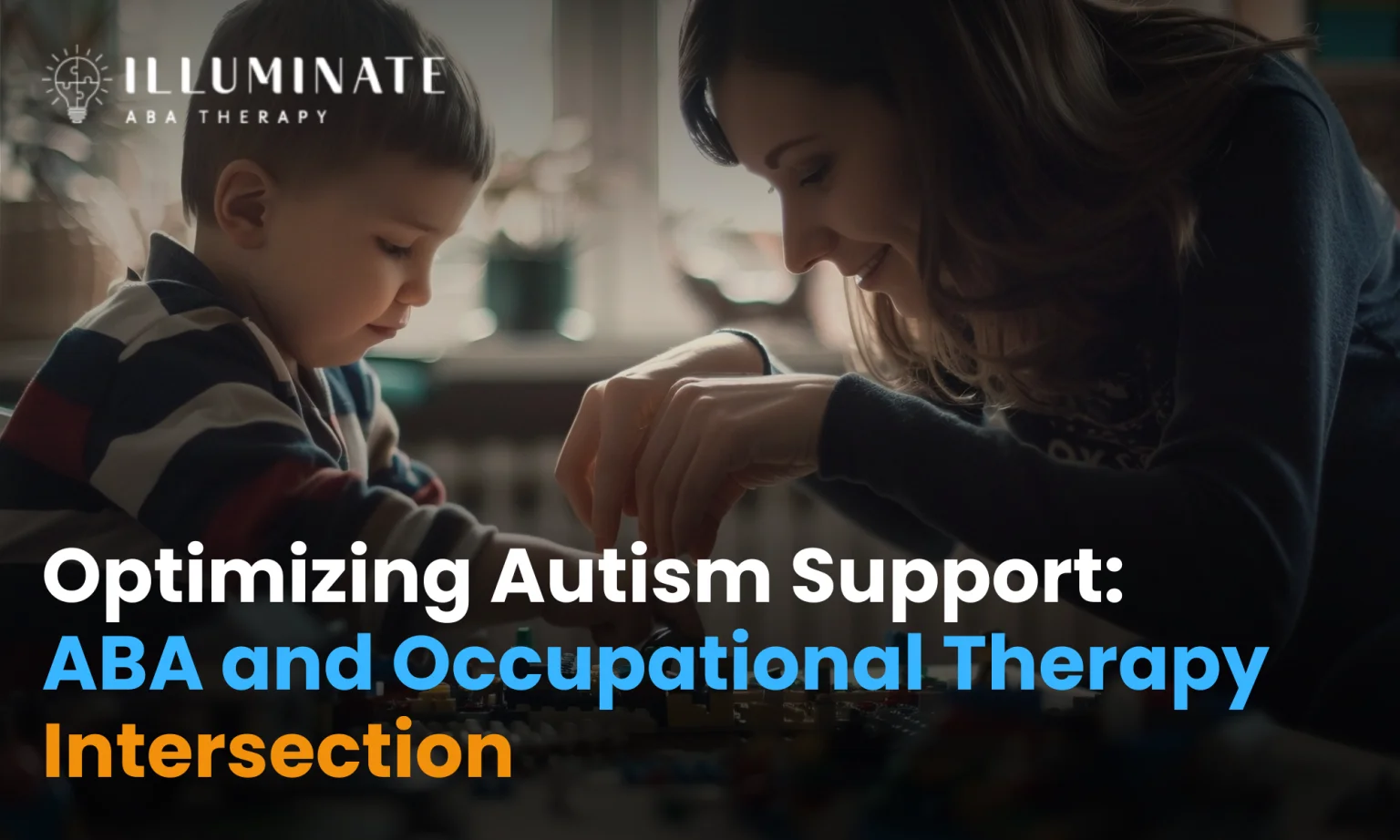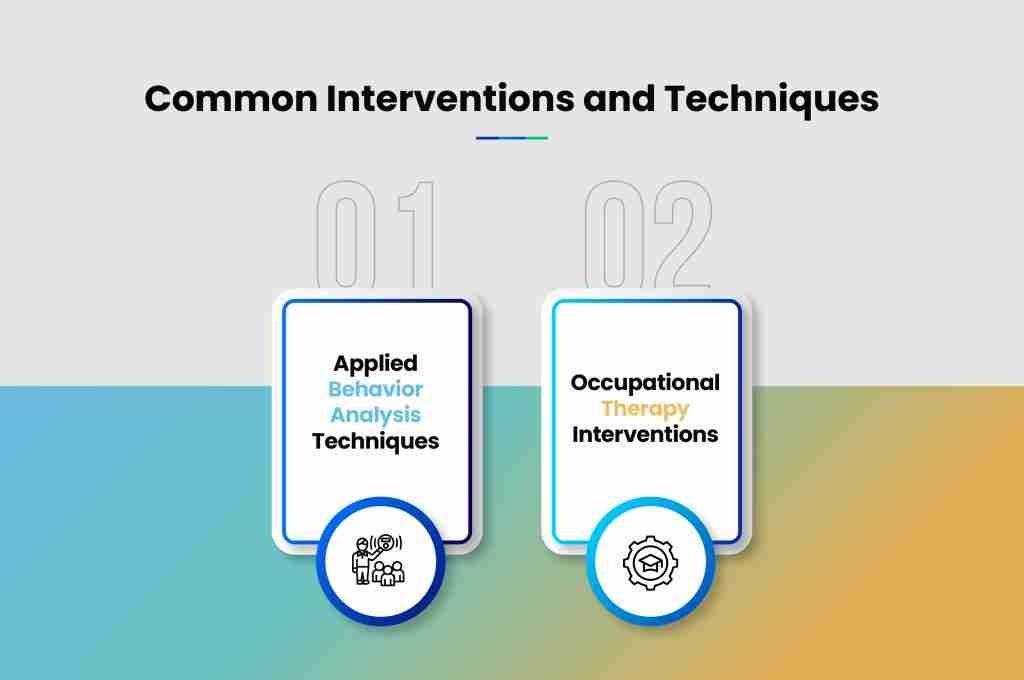Optimizing Autism Support: ABA and Occupational Therapy Intersection
ABA TherapyJuly 17, 2025

Understanding ABA Therapy and Occupational Therapy
When it comes to providing comprehensive support for individuals with autism, a combination of ABA therapy and occupational therapy offers a holistic approach to address a range of developmental and behavioral challenges.
Overview of ABA Therapy for Autism
ABA therapy, which stands for Applied Behavior Analysis, is a well-established and evidence-based approach for individuals with autism spectrum disorder (ASD). By breaking down behaviors into smaller components, ABA therapy aims to teach and reinforce positive behaviors while reducing harmful or challenging ones. This therapy is highly individualized, focusing on the specific needs of the person with autism.
ABA therapy utilizes various techniques such as reinforcement, prompting, shaping, and chaining to teach new skills and behaviors. Data collection and analysis play a central role in monitoring progress and modifying interventions to meet the evolving needs of the individual. To explore specific ABA techniques in more depth, refer to our article on using video modeling to enhance social skills in autism.
Introduction to Occupational Therapy for Autism
Occupational therapy (OT) is another essential component in supporting individuals with autism. Unlike ABA therapy, which primarily focuses on behavior modification, occupational therapy targets the development of daily living skills, fine motor skills, sensory processing, and social interaction. Occupational therapists work to improve practical skills that enable individuals to participate more independently in their daily activities.
Occupational therapy interventions may include sensory integration activities, motor coordination exercises, self-care training, and social skills development. By addressing these areas, occupational therapists help individuals with autism enhance their quality of life and independence. For insights into the impact of music therapy on children with autism from an ABA perspective, check out our article on the impact of music therapy on children with autism: an ABA perspective.
Understanding the distinct roles of ABA therapy and occupational therapy is fundamental in maximizing support for individuals with autism. By integrating these two approaches, individuals can benefit from a comprehensive treatment plan tailored to their unique strengths and areas of development.
The Synergy of ABA and Occupational Therapy
In the realm of autism therapy, the intersection of Applied Behavior Analysis (ABA) and Occupational Therapy (OT) holds significant value in providing comprehensive support for individuals with autism spectrum disorder (ASD). The collaboration between ABA and OT can create a powerful synergy in addressing the unique needs of individuals with autism.
How ABA and OT Complement Each Other
ABA therapy focuses on behavior modification and reinforcement strategies to teach new skills and reduce challenging behaviors in individuals with autism. On the other hand, Occupational Therapy (OT) emphasizes improving functional skills and promoting independence in daily activities. These two therapeutic approaches complement each other by targeting different areas of development:
Aspect
ABA Therapy
Occupational Therapy
Target
Behavior modification and skill acquisition
Development of functional skills
Approach
Behavior-based interventions
Activity-based interventions
Focus
Addressing behavior challenges
Enhancing daily living skills
Techniques
Applied Behavior Analysis techniques
OT interventions tailored to individual needs
By combining the behavioral focus of ABA with the functional approach of OT, individuals with autism can benefit from a holistic intervention plan that addresses a wide range of skills necessary for their overall well-being. The collaboration between ABA and OT allows for a more comprehensive and individualized approach to therapy, considering the unique strengths and challenges of each individual.
Benefits of Integrating ABA and Occupational Therapy
The integration of ABA and Occupational Therapy offers a multitude of benefits for individuals with autism:
- Comprehensive Skill Development: By blending ABA's behavior-focused interventions with OT's functional skill enhancement techniques, individuals with autism can see improvements in various areas such as social skills, communication, sensory processing, and daily living skills.
- Improved Generalization of Skills: The combination of ABA and OT interventions can promote the generalization of learned skills across different environments and settings. This enhances the individual's ability to apply acquired skills in real-life situations.
- Enhanced Treatment Outcomes: The collaborative approach of ABA and OT increases the effectiveness of therapy by providing a more holistic and tailored intervention plan. This leads to improved outcomes in terms of behavior management, skill acquisition, and overall quality of life for individuals with autism.
- Personalized Support: Integrating ABA and OT allows for the development of personalized treatment plans that cater to the specific needs and goals of each individual with autism. This individualized approach ensures that therapy is tailored to address the unique challenges and strengths of the individual.
By recognizing the complementary nature of ABA and Occupational Therapy and harnessing their combined strengths, individuals with autism can receive optimized support that targets a wide spectrum of skills and behaviors, ultimately promoting their holistic development and well-being.
Common Interventions and Techniques

In the realm of therapy for individuals with autism, two key approaches that play a significant role are Applied Behavior Analysis (ABA) techniques and Occupational Therapy (OT) interventions. Understanding the distinct interventions and techniques offered by each is crucial in providing comprehensive support for individuals on the autism spectrum.
Applied Behavior Analysis Techniques
Applied Behavior Analysis (ABA) is a widely recognized and evidence-based intervention for autism. ABA techniques focus on understanding and modifying behaviors to improve social skills, communication, and overall functioning. The following table outlines some common ABA techniques used in therapy sessions:
ABA Technique
Description
Discrete Trial Training
Structured approach breaking skills down into smaller components, with repeated trials and reinforcement for correct responses.
Naturalistic Teaching
Incorporates learning into everyday situations, promoting generalization of skills in natural settings.
Pivotal Response Training
Targets pivotal areas of a child's development to create widespread positive change in behavior.
Verbal Behavior Therapy
Focuses on teaching communication through the analysis of language functions and reinforcement of language skills.
By utilizing a combination of these ABA techniques, therapists can tailor interventions to address the specific needs and goals of individuals with autism. For more insights on how ABA can enhance social skills, check out our article on using video modeling to enhance social skills in autism.
Occupational Therapy Interventions
Occupational Therapy (OT) plays a vital role in supporting individuals with autism in developing skills for daily living and improving overall quality of life. OT interventions focus on enhancing fine motor skills, sensory processing, and independence in activities of daily living. Here are some common occupational therapy interventions used in the context of autism support:
OT Intervention
Description
Sensory Integration Therapy
Addresses sensory processing challenges by providing structured activities to help regulate sensory input.
Fine Motor Skill Development
Exercises and activities designed to improve hand-eye coordination, dexterity, and fine motor control.
Activities of Daily Living (ADL) Training
Teaches essential life skills such as dressing, feeding, and grooming to promote independence.
Visual Supports and Strategies
Utilizes visual aids and supports to enhance communication, organization, and routine adherence.
The collaboration between ABA and OT professionals allows for a holistic approach to supporting individuals with autism. By integrating ABA techniques and OT interventions, a multidimensional treatment plan can be developed to address the diverse needs of individuals on the autism spectrum. For more information on maximizing the benefits of collaboration between disciplines, explore our article on how to effectively collaborate with schools for ABA support.
Maximizing Support for Autism
When it comes to providing comprehensive support for individuals with autism, a collaborative approach that integrates ABA therapy and occupational therapy (OT) has been shown to be highly effective. This synergistic combination allows for a holistic and personalized treatment plan tailored to the unique needs of each individual.
Collaborative Approach of ABA and Occupational Therapy
The collaborative approach of ABA therapy and occupational therapy aims to leverage the strengths of each discipline to address a wide range of skills and behaviors in individuals with autism. ABA therapy focuses on behavior modification and skill acquisition through systematic interventions, while occupational therapy targets the enhancement of daily life skills and sensory processing.
By combining the principles and techniques of both ABA and occupational therapy, individuals with autism benefit from a comprehensive intervention plan that addresses various aspects of their development. This collaborative approach fosters a well-rounded support system that not only targets behavioral challenges but also enhances adaptive skills essential for daily functioning.
Personalized Treatment Plans for Individuals with Autism
One of the key advantages of integrating ABA therapy and occupational therapy is the ability to create personalized treatment plans that cater to the specific needs and goals of each individual with autism. These plans are tailored to address the unique strengths, challenges, and preferences of the individual, ensuring that interventions are not only effective but also engaging and meaningful.
By incorporating personalized treatment plans, therapists can target specific areas of development, such as communication, social skills, motor coordination, and sensory processing, in a structured and individualized manner. This personalized approach allows for gradual progress and skill acquisition, leading to long-lasting improvements in various aspects of daily life.
To further explore the intersection of ABA therapy and occupational therapy for autism, individuals and caregivers can benefit from understanding the impact of music therapy on children with autism from an ABA perspective and promoting self-regulation skills in children with autism through ABA. By delving into these interconnected therapies, individuals with autism can receive comprehensive and tailored support that maximizes their potential for growth and development.
